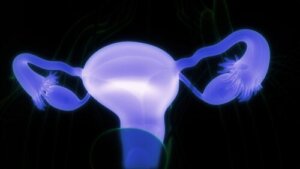Ovarian Dermoid Cysts: Symptoms and When to See a Doctor


Reviewed and approved by the doctor Leonardo Biolatto
Dermoid cysts are saccular growths containing hair, teeth, fluid, and glandular tissue. They can form in the skull, spinal cord, face, and ovaries. In this case, we will discuss ovarian dermoid cysts.
These cysts usually form before birth, are slow growing, and are generally benign. They are also called mature cystic teratomas because of their histological features. They don’t appear in response to hormonal changes associated with the menstrual cycle.
Currently, these cysts represent the most common teratomas and account for 10% to 20% of ovarian tumors worldwide, according to studies. In girls and adolescents, their prevalence is as high as 50%. They’re also considered the most common ovarian tumors during pregnancy.
The common symptoms of ovarian dermoid cysts
Ovarian dermoid cysts cause no symptoms and can go unnoticed in up to 85% of cases, according to research. For this reason, diagnosis is usually incidental, during a routine imaging exam.
Larger ovarian cysts can cause warning signs and symptoms. This is more common in women of reproductive age, between the ages of 20 and 40.
In this regard, some of the common symptoms of ovarian dermoid cysts are as follows:
- Constipation
- Pelvic pain
- Nausea and vomiting
- Abdominal distension
- Difficulty urinating
- Lower abdominal pain
- Pain during sexual intercourse
- Increased or decreased appetite
- Palpable mass in the lower abdomen
We think you may also enjoy reading this article: Ovulatory Dysfunction: What Is it and How to Deal with It?
Rare symptoms
In general, ovarian dermoid cysts are small and measure between 1 to 10 centimeters. However, there are some larger growths that can reach more than 15 centimeters.
Large cysts often cause several rare symptoms:
- A fever
- Vaginal bleeding
- Severe abdominal pain
- Unintentional weight loss

What causes ovarian dermoid cysts?
Mature cystic teratomas develop during intrauterine life, before birth. They form from the abnormal growth of germ cells, which eventually give rise to skin, hair, teeth, and nerve pathways.
This creates a heterogeneous mass of various tissues that encapsulate and accumulate inside the ovaries. Occasionally, glands also develop within the cyst, which promotes sebum production and progressive growth of the tumor.
Why do dermoid cysts often have hair and teeth?
Germ cells are the primordial units from which all human organs and tissues are formed. During the growth of the fetus, they differentiate into three layers:
- Ectoderm: The upper layer that gives rise to skin, hair, teeth, and glands.
- Mesoderm: The middle layer that develops into muscle and connective tissue.
- Endoderm: The lower layer that gives rise to the intestine, bladder, and most viscera.
In this sense, when germ cells grow atypically, they promote the formation of mature tissue, such as hair and teeth, which agglomerate and originate the dermoid cyst. Similarly, these tumors can also contain tissue from any of the other germ layers.
Like this article? You may also like to read: 5 Facts Every Woman Should Know About Ovarian Cysts
Complications
Larger ovarian dermoid cysts have a worse prognosis and are associated with a higher risk of complications. Ovarian torsion and cyst rupture are the two most frequent problems of these tumors.
In rare cases, there is a risk of malignancy.
Ovarian torsion
This complication appears when the ovary rotates on its own axis, as well as around the ligaments and tissues that hold it in position. Thus, there is compression of the blood vessels that nourish the ovary and part of the fallopian tube.
The most frequent symptoms are cramping and intermittent cramps in the lower abdomen, nausea, and vomiting. Ovarian torsion is a medical emergency that requires a surgical approach as soon as possible.
Removal of ovarian dermoid cysts reduces a person’s risk of torsion.
Ovarian cyst rupture
Spontaneous rupture of ovarian dermoid cysts is a rare problem that occurs in up to 2% of affected individuals, according to studies. This complication is more frequent in women of reproductive age or during pregnancy.
The spillage of cyst contents increases the likelihood of peritonitis, which worsens the prognosis.This is a medical emergency that usually presents with the following symptoms:
- Tachycardia
- Dizziness and tiredness
- Hypotension
- Loss of consciousness
- Abundant vaginal bleeding
- Severe pain in the lower abdomen
Ovarian cancer
Ovarian dermoid cysts have a low risk of malignancy – about 1-2 %, according to research. In general, the likelihood of developing ovarian cancer increases with age, being more frequent in postmenopausal women.
These cysts can develop into different types of ovarian cancer, with squamous cell carcinoma being the most common. Other forms include adenocarcinoma, malignant melanoma, and transitional cell carcinoma.
Some associated symptoms include the following:
- Abdominal pain
- Unintentional weight loss.
- The sensation of swelling of the abdomen.
- A palpable mass in the lower abdomen.
How are ovarian dermoid cysts diagnosed?
In most cases, ovarian dermoid cysts are an incidental finding during a routine imaging study. Abdominal ultrasound and transvaginal ultrasound are the tests that are associated with a higher rate of identification of these tumors.
On the other hand, nuclear magnetic resonance imaging is another method that can be useful for the detection of this type of teratoma. Data from imaging studies are complemented by physical examination and thorough questioning by health professionals.

What is the treatment for ovarian dermoid cysts?
The treatment plan for mature ovarian teratomas is aimed at eliminating the tumor and preventing long-term problems. In certain cases, it may be necessary to remove the entire affected ovary. Therapeutics depend on the size of the cyst, the patient’s general condition, and future reproductive plans.
Recession procedures for tumor lesions include ovarian cystectomy, to remove only the cyst, and oophorectomy, to remove the entire ovary. They’re usually performed by laparoscopy or minimally invasive surgery.
However, not all ovarian dermoid cysts have an immediate indication for removal. Medical criteria that determine the need for recession surgery include rapid growth of the lesion, large growths, the presence of symptoms, and the risk of malignancy.
When to seek medical attention
Routine examinations with a specialist are critical for the early detection of ovarian dermoid cysts. Likewise, it’s important to be attentive and seek consultation with a health professional in case of symptoms of cyst rupture or ovarian torsion:
- Intense pain and cramps in the abdomen
- Persistent nausea and vomiting
- Dizziness and feeling faint
- Vaginal bleeding
- A fever
Early treatment improves a patient’s quality of life
Timely diagnosis and management of ovarian dermoid cysts lead to a better prognosis in affected women. In general, surgical removal offers a definitive cure for these benign tumors and the risk of recurrence does not exceed 3%. Don’t forget to go for regular check-ups and consult a specialist in the event of any unusual symptoms.
All cited sources were thoroughly reviewed by our team to ensure their quality, reliability, currency, and validity. The bibliography of this article was considered reliable and of academic or scientific accuracy.
- Castaño E, Escribajo J, Martínez B, Castaño Á, et al. Tratamiento quirúrgico de los quistes dermoides de ovario: laparoscopia frente a laparotomía. Procesos de Obstetricia y Ginecología. 2005; 49(9): 479-484.
- Rodríguez A, Aguiler M, Paz M, Fernández J, et al. Tratamiento laparoscópico del quiste dermoide de ovario. Factores asociados a la rotura intraoperatoria, trascendencia clínica y resultados. Procesos de Obstetricia y Ginecología. 2011; 54(7): 358-362.
- Nikam Y, Kapurubandara S. Spontaneously Ruptured Dermoid Cysts and Their Potential Complications: A Review of the Literature with a Case Report. Case Reports in Obstetrics and Gynecology. 2020; 1(10): 1-9
- Goudeli C, Varytimiadi A, Koufopoulos N, Syrios J, et al. An ovarian mature cystic teratoma evolving in squamous cell carcinoma: A case report and review of the literature.2016.
- Rebolledo-P Vilma E, Barrios Betsathe, Isler Luisana, Barillas Ines. Malignización de teratoma maduro de ovario. Rev Obstet Ginecol Venez [Internet]. 2012 Sep [citado 2022 Nov 02] ; 72( 3 ): 177-181.
This text is provided for informational purposes only and does not replace consultation with a professional. If in doubt, consult your specialist.








